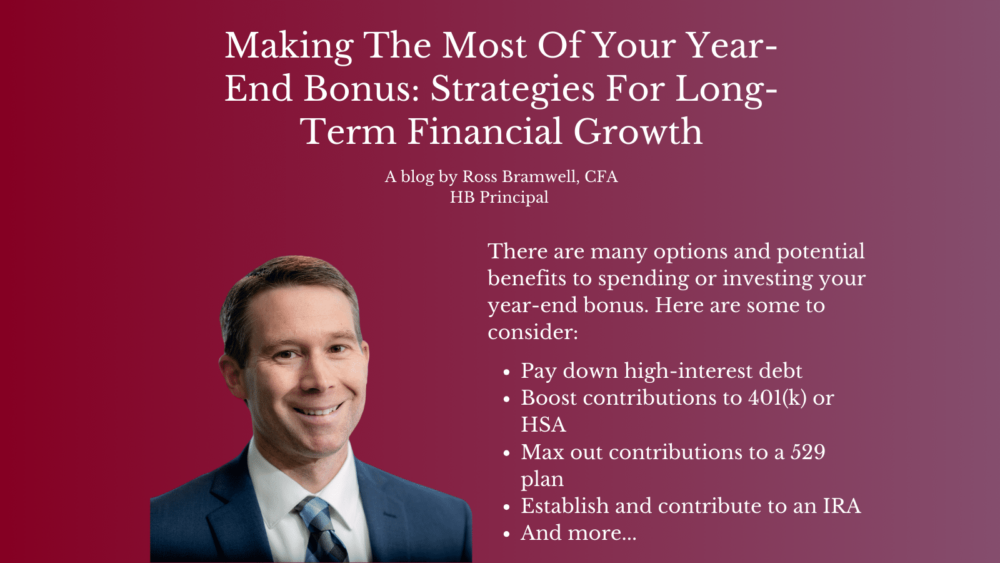Although most of us are in the process of setting new work goals for 2025 and looking at the challenges and opportunities the new year may bring, it’s also a time when past performance is reviewed, often resulting in a well-earned bonus. This annual reward is often in the form of a substantial year-end bonus and means important decisions must be made.
For those who receive a large cash bonus, there are many opportunities and options on how to spend or invest that money. Each of those options and the potential benefits will be based on the specific objectives and circumstances of the person or family. These would include whether you are a young professional, are planning for kids’ or grandkids’ college expenses, or are closer to retirement. A financial advisor can help families determine the best path forward for each scenario.
Now, after a hard-earned bonus is received, it is, of course, natural and right to enjoy a piece of that bonus and spend it on a vacation or a new toy for yourself or your family. Beyond that, there are the traditional options that can be considered:
- Pay down your high-interest debt.
- Boost contributions to your 401(k) or Health Savings Account (HSA) for tax-advantaged growth.
- Max out contributions to a 529 plan. Depending on where you claim residency, your state may offer a state tax deduction for 529 plan contributions.
- Establish and contribute to an IRA. In addition to 401(k) contributions, you can also contribute to a Roth IRA if your income is below certain limits ($161k for single filers and $230k for married filing jointly). Alternatively, you may be able to deduct a contribution to a traditional IRA although the income limits are generally lower and dependent on whether you or your spouse is eligible to participate in an employer plan.
- Make a charitable stock donation to your preferred charity with stocks that have embedded gains. You will receive a tax break for your donated securities. Contributing appreciated stock and using your bonus cash to re-buy the stock at a higher basis resets basis on future capital gains, reducing your taxes in the future.
- Review your insurance coverage, including disability or umbrella liability policies.
- Replenish your emergency savings.
- Invest in stocks and bonds.
For the last one, given that the stock market has been hitting new highs in recent months, investing at market highs can feel daunting, but there are strategies to navigate this uncertainty while growing your wealth. Not only that, but stocks are also broadly considered “expensive” today. However, this should not deter you from investing in your future and ensuring that today’s bonus is working for you over the years to come. There are ways to increase your exposure to the stock market, even in today’s backdrop, without just closing your eyes and feeling like you are blindly buying the market. Three options are:
- Structured notes are designed to meet specific objectives, such as growth, income, or risk management. They do so by combining a traditional security, like a bond, with a derivative component, linked to a stock index in our example. A structured note does not hold an actual underlying portfolio of investments like a mutual fund, or an exchange-traded fund (ETF) does. Instead, the issuer of the note promises to pay a return based on a formula that incorporates the performance of one or more underlying stock indexes. As an example, if we wanted to invest in the S&P 500, we would create a structured note that tracks the performance of the S&P 500 over a predetermined time period. We use these notes to help clients enter the market, or to add risk to their portfolios over time. Investors can also determine the level of risk they want to try to mitigate through either fully principal-protected notes or notes that have a buffer.
- Fully principal-protected notes (PPNs) have a structure that offers a full return of principal at maturity, regardless of how the underlying assets perform. If the underlying stock index had a negative return over the specific period, an investor is made whole upon maturity.
- Buffer notes typically provide protection such that if the buffer level is breached, an investor’s potential principal loss is restricted to the extent of losses more than the buffer. For example, if a note has a buffer of 10% and the underlying index declines 5%, the investor receives full principal back; however, if the reference declines 30% percent, the investor loses 20%.
- Direct indexing is a strategy that looks to replicate a stock index, like the S&P 500 or Russell 3000, through ownership of individual stocks. The strategy involves selling positions that are down to recognize the losses and using those losses to offset capital gains from other positions. This strategy may help reduce your tax bill. Direct indexing strategies can offer systemic solutions to harvest tax losses automatically and opportunistically throughout the year. The portfolio should track the broader index over time but allow for the potential deferral of taxes. This way, if you invest and the market takes a sudden downturn, you have the potential benefit of tax losses in your portfolio to use going forward.
- Dollar-cost averaging (DCA) is the simplest method to invest in the market over time and is a strategy that can make it easier to deal with uncertain markets by making scheduled purchases. DCA involves investing a specific amount over regular, pre-determined time periods. For example, you could invest one-fourth of your bonus and then another one-fourth over the next 90 days, invest at the 30, 60, and 90-day mark. However, we know markets tend to go up over time, so historically this is not the best method to invest. To improve outcomes, you may want to invest 100% in less volatile asset classes such as bonds or hedge funds and limit your DCA to stocks. Also, if stocks do drop, say, 5-10%, it may be worthwhile moving up your purchases to take advantage of a drop.
The potential benefits and risks of each strategy will differ based on individual circumstances. To learn more or get help with your finances, please visit us at homrichberg.com, send an email to info@homrichberg.com, or call 404.264.1400.
Important Disclosures
This article may not be copied, reproduced, or distributed without Homrich Berg’s prior written consent.
All information is as of the date above unless otherwise disclosed. The information is provided for informational purposes only and should not be considered a recommendation to purchase or sell any financial instrument, product, or service sponsored by Homrich Berg or its affiliates or agents. The information does not represent legal, tax, accounting, or investment advice; recipients should consult their respective advisors regarding such matters. This material may not be suitable for all investors. Neither Homrich Berg, nor any affiliates, make any representation or warranty as to the accuracy or merit of this analysis for individual use. Information contained herein has been obtained from sources believed to be reliable but are not guaranteed. Investors are advised to consult with their investment professional about their specific financial needs and goals before making any investment decision.
©2025 Homrich Berg.


